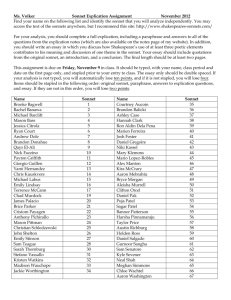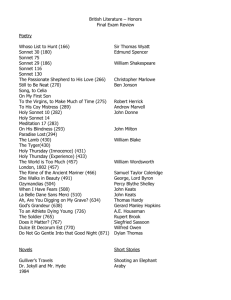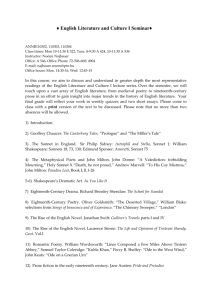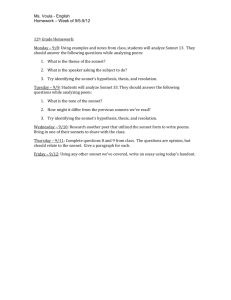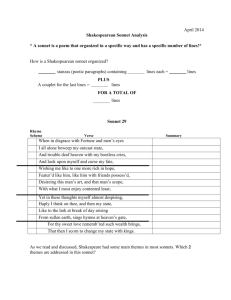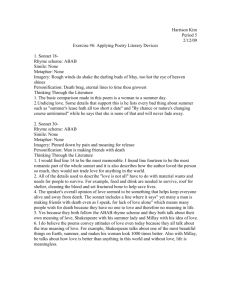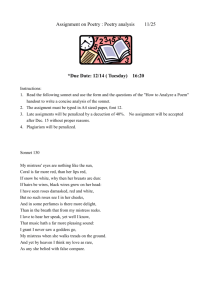Essay 2–Explicate a Renaissance Sonnet
advertisement
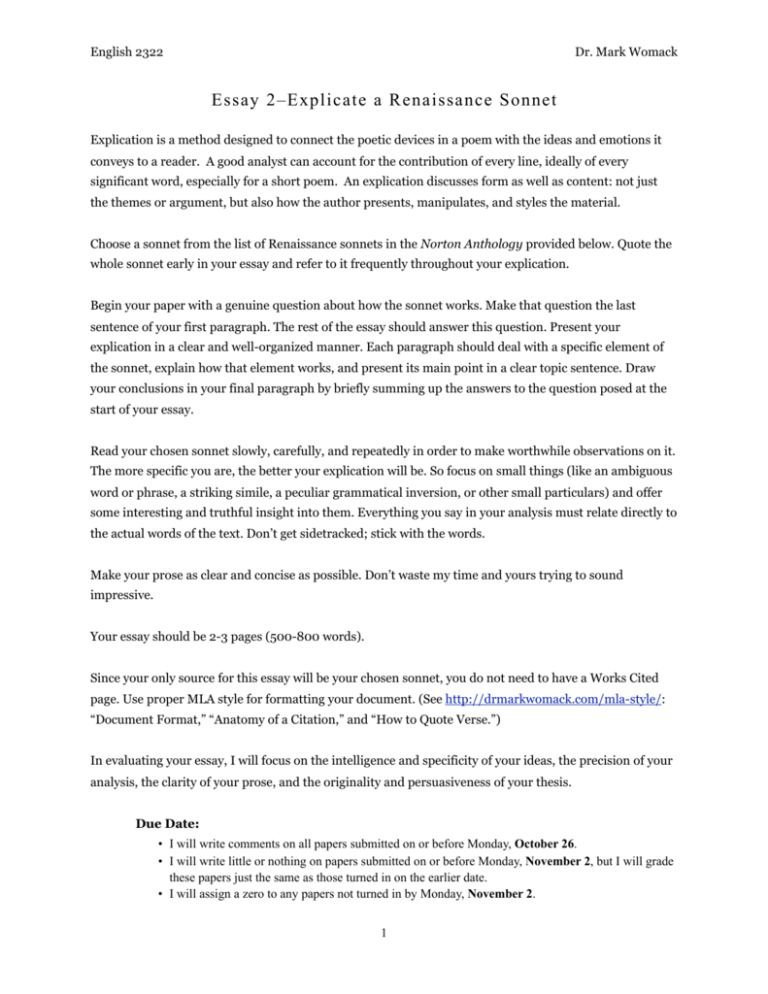
English 2322 Dr. Mark Womack Essay 2–Explicate a Renaissance Sonnet Explication is a method designed to connect the poetic devices in a poem with the ideas and emotions it conveys to a reader. A good analyst can account for the contribution of every line, ideally of every significant word, especially for a short poem. An explication discusses form as well as content: not just the themes or argument, but also how the author presents, manipulates, and styles the material. Choose a sonnet from the list of Renaissance sonnets in the Norton Anthology provided below. Quote the whole sonnet early in your essay and refer to it frequently throughout your explication. Begin your paper with a genuine question about how the sonnet works. Make that question the last sentence of your first paragraph. The rest of the essay should answer this question. Present your explication in a clear and well-organized manner. Each paragraph should deal with a specific element of the sonnet, explain how that element works, and present its main point in a clear topic sentence. Draw your conclusions in your final paragraph by briefly summing up the answers to the question posed at the start of your essay. Read your chosen sonnet slowly, carefully, and repeatedly in order to make worthwhile observations on it. The more specific you are, the better your explication will be. So focus on small things (like an ambiguous word or phrase, a striking simile, a peculiar grammatical inversion, or other small particulars) and offer some interesting and truthful insight into them. Everything you say in your analysis must relate directly to the actual words of the text. Don’t get sidetracked; stick with the words. Make your prose as clear and concise as possible. Don’t waste my time and yours trying to sound impressive. Your essay should be 2-3 pages (500-800 words). Since your only source for this essay will be your chosen sonnet, you do not need to have a Works Cited page. Use proper MLA style for formatting your document. (See http://drmarkwomack.com/mla-style/: “Document Format,” “Anatomy of a Citation,” and “How to Quote Verse.”) In evaluating your essay, I will focus on the intelligence and specificity of your ideas, the precision of your analysis, the clarity of your prose, and the originality and persuasiveness of your thesis. Due Date: • I will write comments on all papers submitted on or before Monday, October 26. • I will write little or nothing on papers submitted on or before Monday, November 2, but I will grade these papers just the same as those turned in on the earlier date. • I will assign a zero to any papers not turned in by Monday, November 2. 1 Explication Here is a list of suggestions to help you explicate your sonnet. These suggestions are a guide, not a set of ironclad rules. They are not comprehensive, nor is every recommendation invariably useful. 1. Read the sonnet for meaning. Pay attention to the sentence, not the line, as the principal unit of organization. Find the subject and verb. Forget, for the moment, about the poetry. 2. Try to summarize the main idea or ideas. (Do this in writing: having to commit conclusions to paper forces you to decide what you think. Don’t include your summary in your essay.) 3. Outline the progression of ideas, identifying major sections. What type of sonnet (Italian, English, Spenserian) is it? Is there a clear system of organization? Are there antitheses? Repetitions? Shifts in direction? 4. What is the specific and general context? How does context (speaker, situation) modify the poem? 5. Is irony a factor? Is there, in other words, a discrepancy between the speaker’s words and meanings? 6. What is the speaker’s attitude towards the subject? towards the hearers? towards him- or herself? In other words, what is the tone? 7. Examine the diction of the sonnet. After reading for denotation (straightforward meaning), think about connotation. Look up key words in the Oxford English Dictionary to determine their currency in the Renaissance and to discover implied significance. Notice connections among roots or words, as well as alternative or archaic (but still applicable) meanings. 8. Think about wordplay, remembering that puns need not be funny. Consider multiple or ambiguous senses of words. 9. Notice imagery. Is it particularly abundant? unusually sparse? Do the images suggest patterns or form clusters? How do the images promote or clarify the subject? 10. What about figurative language: similes, metaphors, symbols? Analyze metaphors with an eye on the tenor (the thing being described), the vehicle (the thing used to describe it), and the connotations of the comparison. 11. Are there classical, biblical, or historical allusions? What do they contribute? 12. Do you find understatement, hyperbole, personification, paradox? 13. Study the syntax, the arrangement of words into sentences. Is word order normal or inverted? Do sentences seem simple or complex? 14. Examine meter as you have syntax. Is it regular or not? Look for run-on lines or important instances of caesura. 15. Pay attention to musical devices such as alliteration, rhyme, assonance, consonance, euphony, cacophony, onomatopoeia. How do they contribute to the sonnet’s effect on a reader? 16. For every device, the essential question is “How does it work?” 2 Sonnets in the Norton Anthology Edmund Spenser Amoretti 1, 34, 37, 54, 64, 65, 67, 68, 74, 75, 79 (902-07) Sir Walter Ralegh Sir Walter Ralegh to His Son, “Methought I saw the grave where Laura lay” (918-19, 921-22) Fulke Greville Caelica 100 (993) Samuel Daniel Delia 33, 45, 46 (998-99) Michael Drayton Idea “To the Reader of These Sonnets,” 6, 61 (999-1000) William Shakespeare Sonnets 19, 23, 35, 55, 62, 65, 74, 80, 85, 87, 93, 97, 98, 105, 106, 107, 110, 128, 135 (1063-75) Richard Barnfield Cynthia 9, 11 (1234) John Donne Holy Sonnets 1, 5, 7, 9, 10, 11, 13, 14, 17, 18, 19 (1295-99) Ben Jonson “To My Book,” “To William Camden,” “A Sonnet, to the Noble Lady, the Lady Mary Wroth” (1427, 1428, 1438) Mary Wroth Pamphilia to Amphilanthus 1, 16, 39, 40, 68, 77, 103 (1457-61) George Herbert “Redemption,” “Prayer” (I), “The Holdfast” (1607, 1611, 1619) John Milton “How Soon Hath Time,” “When I Consider How My Light is Spent,” “On the Late Massacre in Piedmont,” “Methought I Say My Late Espousèd Saint” (1826-29) 3
